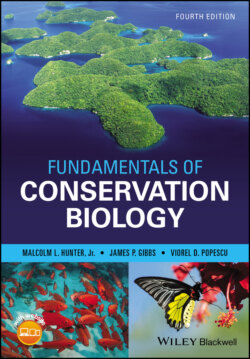Читать книгу Fundamentals of Conservation Biology - Malcolm L. Hunter Jr. - Страница 57
Medicine
ОглавлениеThere was a time when essentially all of our medicines, like all of our foods, came directly from wild organisms. Traditional medicines remain a conspicuous and valuable legacy of this past. This is especially true in developing countries where most of the world’s population resides and where much of the population may still depend on herb markets and herbalists as the primary source of medicine. It is also true in industrialized countries where herbal medicines are worth billions of dollars per year (Fabricant and Farnsworth 2001). A less obvious legacy persists in modern pharmaceuticals, about half of which include chemicals directly obtained from organisms or originally isolated and identified in an organism and then later synthesized by chemists (David et al. 2015). If you include non‐active ingredients the proportion is larger. For example, next time you are at a pharmacy read the ingredients list for the widely used hemorrhoid treatment “Preparation H”; you will find five diverse species represented as shark liver oil, beeswax, corn oil, sheep lanolin, and thyme oil. It is nearly impossible to attach a monetary figure to all of these values, but it is almost certainly in the hundreds of billions of dollars per year (Principe 1996; Kumar 2004).
Plants are a primary source of medicinal chemicals, largely because they have developed a wide diversity of complex organic chemicals (often known as secondary compounds) for deterring plant‐eating animals and other functions. One of the earliest examples is particularly poignant. Silphion was a plant in the carrot family from north Africa that became a major trade commodity in the Greek and Roman empires, primarily because of its efficacy as a human contraceptive (Fig. 3.6). Attempts to domesticate it failed and overexploitation of the wild population continued until it became so rare that it was worth more than its weight in silver. As with most extinctions it is difficult to determine the date, but by 77 CE when Pliny the Elder wrote his natural history, it had not been seen for many years (Parejko 2003).
Figure 3.6 Silphion was a plant of such great commercial value that it was depicted on Greek coins. However, its use (chiefly as a contraceptive) was short‐lived because it was apparently overharvested into extinction roughly 2000 years ago.
(CNG Coins/Wikimedia Commons/CC BY‐SA 3.0)
Despite the advances of modern pharmacology, chemicals obtained or identified from nature remain very important (Cragg and Newman 2013). For example, in the Pacific Northwest of the United States the Pacific yew was transformed from a “trash tree” with no value as timber into an important medicinal plant when it was discovered to contain taxol, a chemical that has proven very effective in the treatment of ovarian cancer and breast cancer (Miller et al. 2008). Another example comes from the mountains of Ecuador where a rare shrub, Diplostephium rhododendroides, is the source of chemicals with great promise in the treatment of hepatitis C and diabetes (Ibrahim et al. 2013). Surveys for medically important plants have long been expedited by consulting with local people about their use of local plants (although less often sharing the commercial benefits of doing so); indeed there is a whole journal, the Journal of Ethnopharmacology, devoted to the topic, along with various journals that cover ethnobotany.
Medicines derived from microorganisms include penicillin, tetracycline, and most other antibiotics, as well as a variety of vaccines, hormones, and antibodies (Cragg and Newman 2013). Better understanding of the role of the microbiome that occupies the bodies of larger organisms is likely to have profound implications for the practice of medicine, for people, domestic species, and those wild species that demand our attention (Qin et al. 2010; Huttenhower et al. 2012; Redford et al. 2012). An intriguing study from Finland found that young people living in diverse settings (as measured by the diversity of plant species and different types of land use) were less likely to suffer from allergies and this was tied to the diversity and abundance of beneficial bacteria found on their skins (Hanski et al. 2012).
Although animals are the source of some medicines – for example, chemicals used to prevent blood clots have been isolated from the saliva of two blood‐sucking animals, leeches and vampire bats – they are generally more widely used in medical science as biological systems to be investigated for insights. The role of mice, rats, and primates as surrogates for people in medical research is well known, but animals’ contribution to medical science goes far beyond this. For example, research on the metabolism of black bears during their winter dormancy may provide significant insights for medical researchers concerned with kidney function (Stenvinkel et al. 2013). The interplay between wild and domestic animals and humans with respect to emerging diseases such as avian influenza (bird flu), SARS (severe acute respiratory syndrome), and of course COVID 19, which rocked the world in 2020, is another field where medical and conservation sciences intersect and new medicines may be forthcoming.
The role of different species in medicine is of particular interest to conservation biologists because it so clearly highlights the need to maintain biodiversity. From a biochemical perspective every species is unique and thus potentially could be the source of a major scientific breakthrough. If we lose a species, we may have lost an invaluable opportunity. Who knows what modern pharmacologists could do for society if they had access to silphion (the extinct source of birth control mentioned previously) and its active compounds? The scope for screening organisms for their biochemical properties remains enormous, and it promises to be an endless task because of continuous advances in medical technology and the ever‐expanding discovery of new species.
